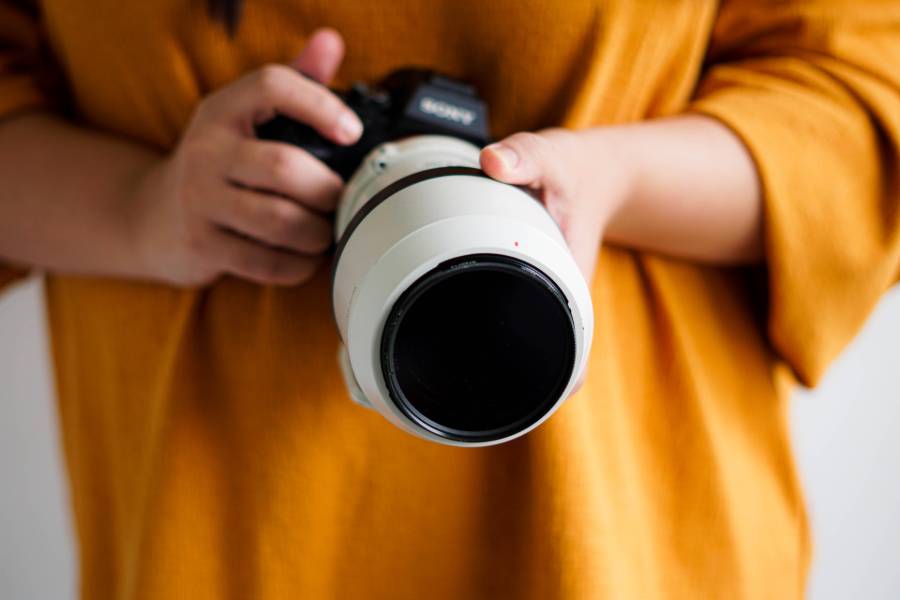
As an Amazon Associate we earn from qualifying purchases.
The best lens for Sony A7RIII ranges from the ability to shoot in low-light, zoom distant objects, and to have a broad field of view for real estate
Quick Navigation
As a real estate photographer, equipping yourself with the best lens for Sony A7RIII will help retain its high-resolution performance in both outdoor and indoor shots. Below, I detail the lenses that pair well with the Sony A7RIII.
The Sony FE 12-24mm f/2.8 is a versatile zoom lens with a bright aperture and an ultra-wide field of view, making it the overall best on our list.
It comes with a constant aperture of f/2.8, making it perform better in poor lighting than the Sony FE 12-24mm f/4.
The Sony FE 12-24mm f/2.8 features a sophisticated optical construction that consists of ED, Super ED, and XA elements, geared towards eliminating the optical distortions and aberrations that are common in wide-angle lenses.
The front elements are fluorine-coated, making them resistant to fingerprints, dust, and moisture, facilitating their use in harsh environments. However, it's the heaviest on my list, making it unsuitable for prolonged shooting periods.
The Sony FE 16-35mm f/2.8 is distinguished by its wide aperture of f/2.8, which remains constant throughout the zoom range. This ensures consistent performance no matter the zoom.
The optical construction employs two XA and two low dispersion elements to minimize the spherical and chromatic aberrations and distortions to achieve high-quality images.
Like the Sony FE 20mm f/1.8, the Nano AR coating helps to limit the surface reflections and ghosting for better color fidelity and increased contrast. With an 11-blades aperture diaphragm, it produces a soft-edged and smooth bokeh.
However, with a weight of 1.5 pounds, it's the second heaviest on my list, significantly limiting its portability.
The Sony FE 35mm f/1.8 is a versatile wide-angle prime with an impressive wide aperture of f/1.8. This aperture makes it ideal for use with selective focus techniques.
It employs the linear motor to enhance the fast and accurate focusing experience. However, the bokeh quality it produces with the nine-blade aperture diaphragm is less appealing than that of the Sony FE 16-35mm f/2.8.
The use of internal focusing design ensures the lens's overall length doesn't change when focusing, making it suitable for shooting camera-shy subjects. It weighs 0.62 pounds, making it the most lightweight on my list and ideal for an extended shooting period.
The Sony FE 12-24mm f/4 is a flexible wide-angle lens with an impressive zoom for shooting distant subjects, making it ideal for outdoor
For color fidelity and improved contrast, it employs Nano AR coating, which helps eliminate the ghosting, surface reflections, and flares. Like the Sony FE 12-24mm f/2.8, it's weather-resistant, making it suitable for shooting in even in the harshest conditions.
The handling is comfortable even in cold temperatures, thanks to the rubberized control rings. However, unlike the Sony FE 35mm f/1.8, the 1.25 pounds weight is not convenient for carrying around.
The Sony FE 20mm f/1.8 is a wide-angle prime that blends intuitive handling and portability, making it an ideal walkaround lens. The optical construction includes three low dispersion and two aspherical elements, which suppresses distortions.
Like the Sony FE 12-24mm f/4, it comes with a Nano AR coating which enhances color fidelity and improves contrast by minimizing surface reflections, ghosting, and flare.
The autofocus is enhanced by the deployment of a dual XD linear motor mechanism, making it smooth, silent, and fast. Like the Sony FE 12-24mm f/2.8, it is weather resistant and suitable for use in moist conditions. However, without zoom capabilities, it's inconvenient for shooting distant subjects.
The Sony FE 24mm f/1.4 is a versatile and fast wide-angle prime, making it excellent for use in nature, landscape, street, and real estate
The aperture offers an impressively shallow depth of field application. However, this aperture is not ideal for shooting in strongly lit situations. It uses two XA and three low dispersion elements to eliminate the chromatic and spherical distortions for enhanced image clarity and sharpness.
It uses the Super Sonic wave Motor for quick, silent, smooth, and accurate focusing performance. Unlike the Sony FE 20mm f/1.8, it features a switch button for instant changing from the autofocus to the manual control.
The Sony Vario-Tessar 16-35mm f/4 is a weather-resistant and compact zoom lens, making it a suitable traveling lens for your Sony A7RIII. Although the f/4 aperture is not great in low-light performance like the Sony FE 16-35mm f/2.8, it maintains consistent performance over the zoom range.
It effectively suppresses spherical and chromatic aberrations, thanks to the five glass elements incorporated in the optical design. Additionally, the use of Zeiss's anti-reflective coating ensures the resulting images are free from ghosting and flare.
Unlike the Sony FE 24mm f/1.4, it features a SteadyShot image stabilization mechanism which significantly reduces the camera shake effect when shooting handheld.
The Tamron 17-28mm f/2.8 is a flexible zoom that covers wide focal lengths, making it excellent for architectural, landscape, astrophotography, and real estate
The optical construction employs LD and XLD elements which help suppress the distortions for enhanced image clarity and sharpness. Besides, the BBAR coating on the lens's elements helps eliminate the ghosting and surface reflections when shooting in harsh lighting situations.
Although heavier than the Sony FE 35mm f/1.8, the 0.98 pounds weight is still lightweight enough to carry around without exhaustion. However, without image stabilization, there are chances of image blurring when zooming.
All Sony A7RIII lenses are not created equal, and some perform better in certain shooting situations than others. Below, we detail some of the features you need to consider in a Sony A7RIII lens based on most shooting conditions.
| Lenses | Diaphragm Blades | Aperture | Weight (Pounds) |
|---|---|---|---|
| Sony FE SEL1224GM | 9 | f/2.8 | 1.87 |
| Sony FE SEL1224G | 7 | f/4 | 1.25 |
| Sony FE SEL20F18G | 9 | f/1.8 | 0.82 |
| Sony FE SEL24F14GM | 11 | f/1.4 | 0.98 |
| Sony FE SEL1635GM | 11 | f/2.8 | 1.5 |
| Sony Vario-Tessar ZA OSS | 7 | f/4 | 1.14 |
| Tamron Di III RXD | 9 | f/2.8 | 0.93 |
| Sony FE SEL35F18F | 9 | f/1.8 | 0.62 |
One of the most important questions you should ask yourself is where you intend to use the lens. If you are planning to use it in dusty or windy conditions, then go for a weather-resistant lens like the Sony FE 12-24mm f/2.8.
Manufacturers equip their lenses with varying spherical and low dispersion elements to help minimize the optical distortions. Also, these elements are coated with special coatings to reduce the surface reflections, ghosting, and flare, which is common when shooting in bright lighting.
The number of these elements translates to the ability of the lens to eliminate the optical aberrations. Therefore, a lens with a high number of optical elements such as the Sony Vario-Tessar 16-35mm f/4 has the minimum optical distortions.

Weight is something that many people overlook when purchasing lenses. Usually, weight isn't a big deal if you are planning to use a tripod with your camera and lens when shooting.
However, if you plan to use a lens for walking around while shooting handheld, then you should consider the weight of this lens plus your gear.
Typically, a heavy lens will make you feel tired faster and at times make your wrists hurt. In the case of a walkaround lens, a lightweight lens such as the Sony FE 35mm f/1.8 is preferable.
Normally, a zoom lock is a feature that is specifically found on certain types of zoom lenses that allows you to lock the barrel at certain focal lengths. Locking the focal length reduces cases of zoom accidentally getting adjusted, especially when you are shooting handheld while moving.
To protect your camera lens from rainwater, you will require a rubber band, plastic bag, and camera hood. It's advisable to use a large bag that will cover the camera and the lens completely.
Before covering, first, attach the camera hood. However, a weather-resistant lens such as the Sony FE 12-24mm f/4 is preferable in such conditions.
The best Sony A7RIII lens for low-light shooting is the one with the widest aperture. Typically, the wide aperture allows more light to enter the lens, which translates to better performance even when the light is not adequate. For instance, the Sony FE 24mm f/1.4 captures impressive shots even in poorly lit situations.
Pairing your Sony A7RIII with the best flashes and lenses can improve your shooting results. Although you may want to purchase the best lens for your Sony A7RIII, the many options in the market might confuse you. However, the above options are versatile, sturdy, and perform well in virtually all situations, and any option won't disappoint.
